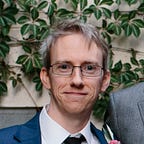Creating Blue Dust #4
Blue Dust is a sci-fi audio fiction series that I created and released in 2022. It tells the story of a teenager named Max returning to his old home, a floating mega-city, to find his father and get his old life back. You can listen on any major podcasting platform, or at https://anchor.fm/blue-dust
This post will focus on the production phase of creating Blue Dust. As opposed to the lengthy pre and post phases, this phase was relatively short. All told, I was in production for four weeks. During production, I focused entirely on scheduling and recording voice actors, so that’s what I’ll describe below.
Instead of scheduling each voice actor individually through emails and messages, I shared a link to my SAE student Google Calendar with recording blocks of three hours. Each voice actor was free to choose whichever slot they would like over four weeks. Unfortunately, I longer have access to the calendar that I was using, since it was connected with my SAE student account. However, I also copied the scheduling information to Trello, which I still have access to.
You can see that there were weeks where I was recording on most days, sometimes twice a day. By “WEEK NINE”, I had only to record myself as Frank, and my friend Danny Hesz as Thragh. We did that together over a few hours.
Recording the voice actors was an extremely rewarding experience. Personally, it was very gratifying to hear the characters of Blue Dust come alive. Sometimes the voice of the character in my mind perfectly matched the actor. At other times, the actor brought a new spin and feel to the character that was unexpected, but truly welcomed.
For each actor, I would bring them into the studio to acquaint them my setup. Since I was new to recording voice actors, and since many of the actors had not done voice acting before, I recorded the actors in the control room with me, as opposed to the recording booth. That way I could give feedback clearly and easily, without any walls and windows between us. It also allowed me to more-closely monitor how close the actor was to the microphone.
Even at the time I understood that this technique was unprofessional. I could only monitor the actors through headphones, since monitors would bleed into the microphone(s). Sometimes I didn’t even use headphones, since I didn’t like hearing two versions of the actor — the one in the headphones and the real actor behind me. For levels, I relied on the input gain and faders. Furthermore, the control room also became very hot, so I left the air conditioner on, which created a slight hum that I had to remove later in post, despite my best efforts to position the mic to reject noise from the air conditioner.
Despite all of this, I don’t regret my decision at all. I made sure that I positioned the microphone in roughly the same place, that I always used the same recording studio (control room), as well as the same microphone, the Neumann TLM103. I believe that Blue Dust has a wonderfully consistent feel in terms of the short timeframe in which I scripted it, discussed in the previous blogpost, but also in its recording. I’m very sensitive to changes in recording conditions, so I’m glad that Blue Dust doesn’t suffer from those problems.
After the actors had been acquianted with the studio set up, we discussed the character they were acting for 5–10 minutes, then started recording. I tried to record at least two takes for each chapter. We would run through the chapter together, me playing the part of any actor who wasn’t in the room. If there were any big gaps between speaking sections, we would skip ahead and I would read a few lines of dialogue before the actor jumped in.
For side characters (Sue, Jed, Frank, Fi, Thragh) I set aside three hours for recording. For main characters (Vertov, Tom, Trigs, Annie), sometimes six hours was required. For Max, I recorded for roughly nine hours spread over four sessions. For some roles, the allotted timeframe was more than enough to cover all three takes. For others, it was difficult to even get two solid takes.
Within each session, a familiar pattern emerged. First, most actors would be a little hesitant and uneasy with the lines, especially if there were emotional tone-shifts or lengthy passages, as was typical for Max, Annie and Vertov. After an hour or so in the studio, invariably the voice actor would relax into the role and there was at least 45 minutes of peak performance. After that, the actor would grow tired, start reading too fast, skip words, and generally lose focus. Usually the last hour was harder than the first two, going over mistakes and redoing lines.
If I were to do this process again, perhaps two-hour sessions would be better, although it would also mean more work scheduling and organising more sessions.
I recorded each actor to Pro Tools, then backed up my sessions and enormous recording files to Google Drive, an external HDD, and eventually to my computer. Now that I had the sessions and files, I had the enormous process of sorting through them all and comping the best takes. I’ll describe that process in my next blogpost on the lengthy postproduction phase.
Thank you for reading
PS: I’d like to thank each actor again for all of their hard work. For a full list of the cast, please see the show notes for each episode.
